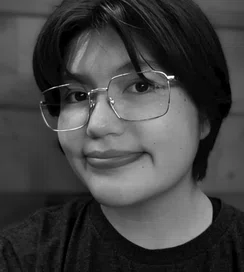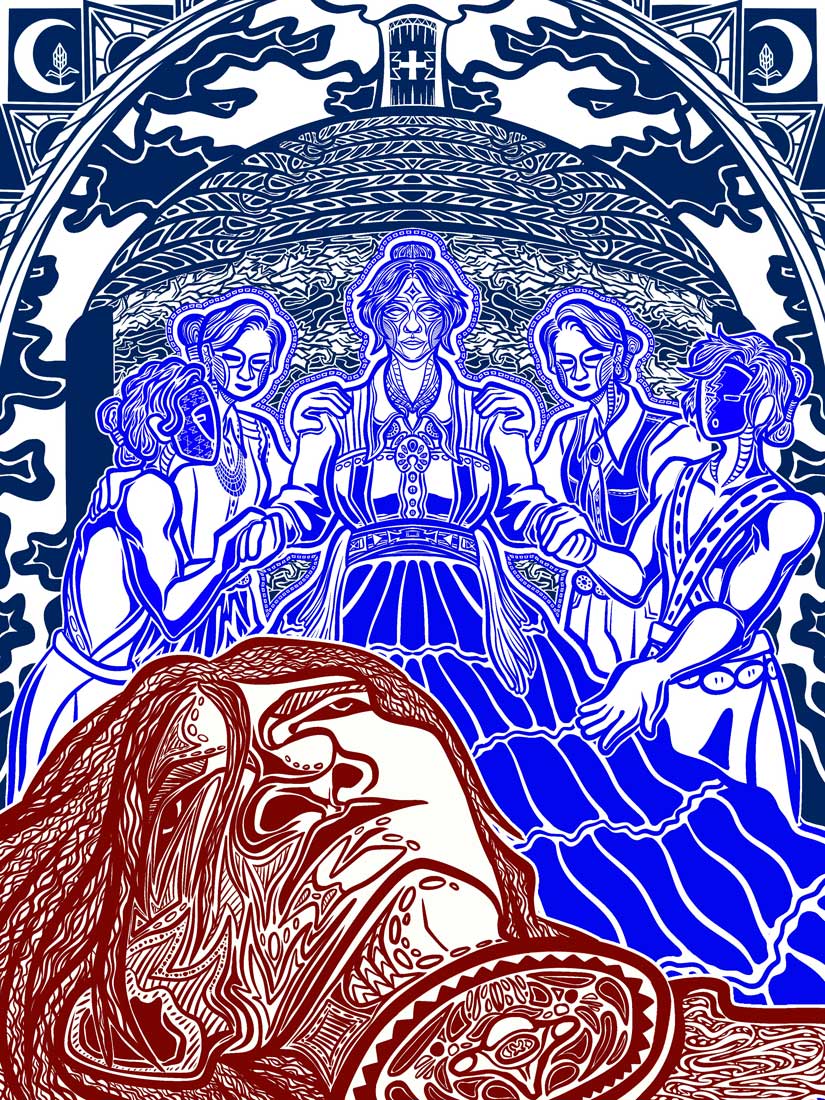

AP 2-D
Aanjé Greymountain
Loy Norrix High School |Kalamazoo, Michigan


Dimensions: 14” x 9”|Materials: Digital art, Procreate|Processes: Hogan for backdrop to show they’re home and time/ techhad advanced. Motifs from Navajo silversmithing.|Idea(s): HeroTwins come home after many years missing. Tells grandparents/mom they finished killing the montsters|Curatorial Note: Another work that stands out differently from other works in the exhibition. It is a digital print, but it looks like a physical print—a great interpretation and representation of a Native American creation story.
Student statement
Student statement

My Native American culture is the most significant influence on my artwork. My mother is Ojibwe, and my father is Diné. I grew up on the Navajo reservation but eventually moved to Michigan, closer to my Ojibwe side. While creating my series of artworks depicting the traditional Navajo story of the Hero Twins, I attempted to honor my ancestors and strengthen my bond to my culture, people, family, and myself.
This specific piece depicts the part in the Hero Twin story when they finally return home to their Mother, Yoolgai asdzáá (Changing Woman), and their grandparents, Altsé asdzáá and Altsé hastiin (First Woman and First Man), after successfully slaying the giant that ate and terrorized the Diné people. The twins proudly present the head of the giant to their family in their long-awaited reunion. I had a tough time creating this piece. For the life of me, I could not find out how to fit in the head of the giant despite it being the central element of the storytelling. After much trial and error and advice from my teacher, I settled on the composition seen here.
The process of creating my Hero Twins series has been one of the most valuable learning experiences in my life, both educationally and personally. I wanted to create this series specifically for a Navajo audience and incorporate symbolism and storytelling techniques that speak directly to our culture and way of life. When I started this journey, I set out with the goal of finding a way to reflect our different cultural art forms and beliefs in my style, use of composition, and symbolic imaging; this, however, was very difficult due to the fact I have been solely taught the western colonist schools of thought when it comes to this. To properly reflect my culture, I was inspired by Navajo silversmithing, rug making, sand painting, basket weaving, ceremonial and traditional attire, our lands, and much more. To execute this properly and truly honor and connect to my Navajo heritage, I did endless research, and most importantly, I spoke with and received guidance from my family.
I would create this series again. My favorite part of being an AP Art and Design student was the opportunity and power to direct my artistic and personal growth, allowing me to spread my wings further and gain more wisdom than in any other educational context.
I studied the traditional Hero Twin Story to help reeducate the Dine People on our traditions and history. It takes place within the larger Diné Bahane Creation story. The Hero Twin story is sacred and long in the Diné culture. Its purpose is to teach people that any Goliath can be defeated and any struggle can be overcome by using wits, strategy, and connection to join forces with others.
TEacher statement
TEacher statement
Greg Stevens
Aanje’s experience developing her works is one that every artist knows all too well—the desire to communicate a message to a broader audience. Although communication is an inherent part of the creative process, an artist's ability to effectively relay that desired meaning separates the powerful works from the mundane. Aanje’s desire to spread the storytelling that is a tenant of her culture through visual means presented a difficult task. What started as a traditional print-making idea became a more modern, detailed way of sharing. Namely, Aanje used digital art techniques to share the Navajo story of the “Hero Twins.” Through her use of traditional patterns, unique perspectives, and stylized compositions, Aanje presented a digital storyboard of the traditional tale that can be shared widely. It is the ease of this dissemination that allowed her to fulfill her goal of passing on her heritage to other tribe members.
The overall structure of AP Art helped Aanje fulfill her goals. Through practice, experimentation, and revision, Aanje successfully fulfilled her vision. Sketchbooks were filled with different compositions, details, and subject matter. What started as a verbal story was written down and divided into visual pieces. Those pieces were then vetted through critiques, self-analyzation, and cohesion. Nothing was considered sacred, and everything was up for discussion, debate, and revision. Through this process, the story of the “Hero Twins” morphed from a verbal Navajo story to a digital, visual representation that can be used to preserve a unique culture.
As a now-experienced AP Art teacher, my advice to other AP teachers is the same as what I often give my students: trust the process. The College Board has provided a structure that allows students to make their art more authentic, conceptual, and personally fulfilling. It’s not so much teaching the technical aspects but the behavioral traits of an artist. Specifically, every element, from ideation, technique, subject matter, and media, must work together to create meaning for the viewer. If a teacher can facilitate that behavior into becoming a habit for an art student, it will serve them well in AP Art and Design and all creative pursuits.
